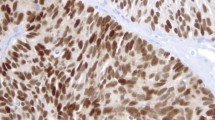Abstract
Neuroendocrine differentiation is a frequent occurrence in common prostatic adenocarcinomas and may have prognostic implications in prostatic malignancies. In the present study, we used immunohistochemical double label methods to evaluate the nuclear androgen receptor (AR) status in endocrine-paracrine (EP) cells of normal, hyperplastic, and neoplastic prostate including tumours that recurred after hormonal and radiation therapy. In normal and hyperplastic glands, EP cells characterized by the panendocrine marker chromogranin A (Chr A) did not reveal AR-positivity. This may indicate that prostatic EP cells represent an androgen-indepenent cell population whose regulatory functions are not influenced by circulating androgens. Unequivocal co-expression of Chr A and AR was very rarely detected in subsets of endocrine differentiated tumour cells in treated and untreated specimens. The widespread absence of nuclear AR in neuroendocrine tumour cells suggests that this phenotype belongs to those cell clones in prostate cancer which are initially androgen-independent and refractory to hormonal therapy.
Similar content being viewed by others
References
Abrahamsson PA, Wadström LB, Alumets J, Falkmer S, Grimelius L (1986) Peptide-hormone and serotonin-immunoreactive cells in normal and hyperplastic prostate glands. Pathol Res Pract 181:675–683
Abrahamsson PH, Wadström LB, Alumets J, et al. (1987) Peptidehormone and serotonin-immunoreactive tumour cells in carcinoma of the prostate. Pathol Res Pract 182:298–307
Aumüller G (1983) Morphologic and endocrine aspects of prostatic function. Prostate 4:195
Böcking A (1981) Reproducible grading of prostate carcinoma based on cytological criteria of malignancy. Akt Urol 12:278–282
Bonkhoff H, Remberger K (1993) Widespread distribution of nuclear androgen receptors in the basal cell layer of the normal and hyperplastic human prostate. Virchows Arch [A] 422:35–38
Bonkhoff H, Wernert N, Dhom G, Remberger K (1991) Relation of endocrine-paracrine cells to cell proliferation in normal, hyperplastic and neoplastic human prostate. Prostate 18:91–98
Dauge MC, Delmas V (1987) APUD type endocrine tumour of the prostate: incidence and prognosis in association with adenocarcinoma. In: Murphy GP, Khoury S, Klüss R, Chatelain C, Denis L (eds) Prostate cancer. Part A: research, endocrine treatment, and histopathology. Liss, New York, pp 529–531
Di Sant'Agnese PA (1988) Neuroendocrine differentiation and prostatic carcinoma. Arch Pathol Lab Med 112:1097–1099
Di Sant'Agnese PA (1992) Neuroendocrine differentiation in human prostate carcinoma. Hum Pathol 23:287–296
Di Sant'Agnese PA, Mesy Jensen KL de (1984) Endocrine-paracrine cells of the prostate and prostatic urethra: an ultrastructural study. Hum Pathol 15:1034
Di Sant' Agnese PA, Mesy Jensen KL de, Churukian CJ, et al. (1985) Human prostatic endocrine-paracrine (APUD) cells. Arch Pathol Lab Med 109:607
English HF, Santen RJ, Isaacs JT (1987) Response of glandular versus basal rat ventral prostatic epithelial cells to androgen withdrawal and replacement. Prostate 11:229–242
Gorelic LS, Lamm DL, Ramzy I, Radwin HM, Shain SA (1987) Androgen receptors in biopsy specimens of prostate adenocarcinoma — heterogeneity of distribution and relation to prognosis significance of receptor measurements for survival of advanced cancer patients. Cancer 60:211–219
Isaacs JT, Coffey DS (1989) Etiology and disease process of benign prostatic hyperplasia. Prostate 2:33–50
Kwast TH van der, Schalken J, Ruizeveld de Winter JA, Vroonhoven CCJ van, Mulder E, Boersma W, Trapman J (1991) Androgen receptors in endocrine-therapy-resistant human prostate cancer. Int J Cancer 48:189–193
Masai M, Sumiya H, Akimoto S, Yatani R, Chang C, Liao S, Shimazaki J (1990) Immunohistochemical study of androgen receptor in benign hyperplastic and cancerous human prostates. Prostate 17:293–300
Ruizeveld de Winter JA, Trapman J, Brinkmann AO, Boersma WJA, Mulder E, Schroeder FH, Claassen E, Kwast TH van der (1990) Androgen receptor heterogeneity in human prostatic carcinomas visualized by immunohistochemistry. J Pathol 161:329
Sadi MV, Walsh PC, Barrack ER (1991) Immunohistochemical study of androgen receptors in metastatic prostate cancer — comparison of receptor content and response of hormonal therapy. Cancer 67:3057–3064
Zegers ND, Claassen E, Neelen C, Mulder E, Van Laar JH, Voor-horst MM, Berrevoets CA, Brinkmann AO, Kwast TH van der, Ruizeveld de Winter JA, Trapman J, Boersma WJA (1991) Epitope prediction and confirmation for the human androgen receptor: generation of monoclonal antibodies for multi-assay performance following the synthetic peptide strategy. Biochem Biophys Acta 1073:23–32
Author information
Authors and Affiliations
Additional information
This study was supported by the Deutsche Forschungsgemeinschaft Bo-1018/1-5
Rights and permissions
About this article
Cite this article
Bonkhoff, H., Stein, U. & Remberger, K. Androgen receptor status in endocrine-paracrine cell types of the normal, hyperplastic, and neoplastic human prostate. Vichows Archiv A Pathol Anat 423, 291–294 (1993). https://doi.org/10.1007/BF01606893
Received:
Revised:
Accepted:
Issue Date:
DOI: https://doi.org/10.1007/BF01606893




